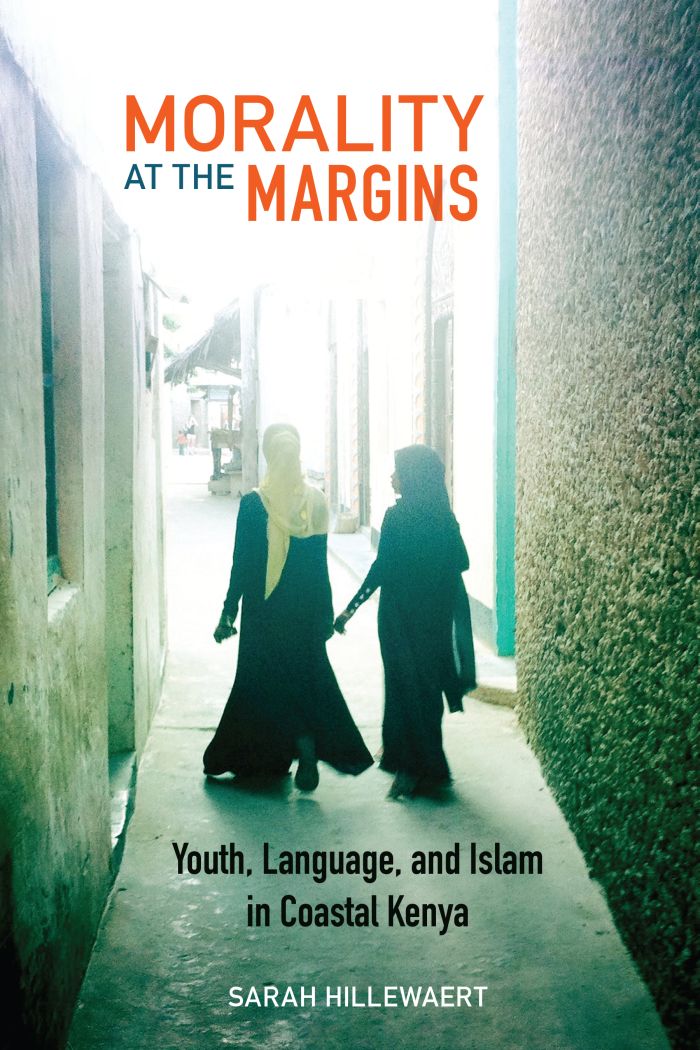Morality at the Margins
Youth, Language, and Islam in Coastal Kenya

This book can be opened with

This book considers the day-to-day lives of young Muslims on Kenya’s island of Lamu, who live simultaneously on the edge and in the center. At the margins of the national and international economy and of Western notions of modernity, Lamu’s inhabitants nevertheless find themselves the focus of campaigns against Islamic radicalization and of Western touristic imaginations of the untouched and secluded.
What does it mean to be young, modern, and Muslim here? How are these denominators imagined and enacted in daily encounters? Documenting the everyday lives of Lamu youth, this ethnography explores how young people negotiate cultural, religious, political, and economic expectations through nuanced deployments of language, dress, and bodily comportment. Hillewaert shows how seemingly mundane practices—how young people greet others, how they walk, dress, and talk—can become tactics in the negotiation of moral personhood.
Morality at the Margins traces the shifting meanings and potential ambiguities of such everyday signs—and the dangers of their misconstrual. By examining the uncertainties that underwrite projects of self-fashioning, the book highlights how shifting and scalable discourses of tradition, modernity, secularization, nationalism, and religious piety inform changing notions of moral subjectivity. In elaborating everyday practices of Islamic pluralism, the book shows the ways in which Muslim societies critically engage with change while sustaining a sense of integrity and morality.
In this gorgeous ethnography, Sarah Hillewaert sketches what it means to be modern in a time of significant transformation. Through elegant prose and well-honed analytical insight, she illustrates how everyday walking, talking, and gesture come to bear on what it means to be a pious and moral young person, both individually and socially. Morality at the Margins offers a vital contribution to localized understandings of Islam, youth, and our changing world.—Shalini Shankar, Northwestern University
Hillewaert offers a full and rich depiction of social, cultural, and linguistic life in a fast-changing place with a fascinating history. The ethnography is superb, and the focus on youth is especially welcome.—Susan F. Hirsch, George Mason University
Hillewaert’s book furnishes a wonderfully detailed and clear ethnographic and linguistic analysis of a town society long of interest to scholars but sorely in need of updated scholarly work.The ethnographic vignettes and dialogues bring the broader points to life, while the author unpacks theoretical concepts with sensitivity to the needs of the reader new to anthropology.—Janet McIntosh, Brandeis University
Gesturing to the changing nature of social hierarchies in this historic Swahili town, this book opens up an important discussion on the role of language and materiality in both signifying and complicating social inequities in a conservative Muslim society, while also highlighting new expressions of moral belonging among youth in Lamu. Moreover, the heshima, or respect, that Hillewaert shows her host community and interlocutors makes this work a model for ethical engagement with ethnographic research subjects.—African Studies Review
Preface | ix
Introduction | 1
Interlude 1: Mila Yetu Hufujika (Our Traditions Are Being Destroyed), by Mahmoud Ahmed Abdulkadir | 41
1. “This Is Lamu”: Belonging, Morality, and Materiality | 46
2. Dialects of Morality | 76
Interlude 2: kiSwahili, by Mahmoud Ahmed Abdulkadir | 114
3. “Youth” as a Discursive Construct | 121
4. Reframing Morality through Youthful Voices | 153
Interlude 3: Tupijeni Makamama (Let’s Embrace), by Mahmoud Ahmed Abdulkadir | 187
5. Senses of Morality and Morality of the Senses | 191
Epilogue | 233
Appendix: Note on Language | 247
Acknowledgments | 257
Notes | 261
Bibliography | 271
Index | 293





